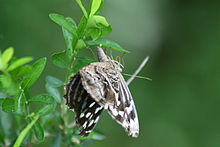| Adelia | |
|---|---|

| |
| A. vaseyi with ovipositing Myscelia ethusa | |
| Scientific classification | |
| Kingdom: | Plantae |
| Clade: | Tracheophytes |
| Clade: | Angiosperms |
| Clade: | Eudicots |
| Clade: | Rosids |
| Order: | Malpighiales |
| Family: | Euphorbiaceae |
| Subfamily: | Acalyphoideae |
| Tribe: | Adelieae |
| Genus: | Adelia L. 1759, conserved name, not P.Browne 1756 (Oleaceae) |
| Synonyms[1][2] | |
|
Ricinella Müll.Arg. | |
Adelia is a genus of flowering plants in the spurge family, Euphorbiaceae, subfamily Acalyphoideae.[1] It is native to Latin America and the Caribbean, with one species extending northward into the southernmost part of Texas.[2][3][4][5][6][7]
The name is derived from the Greek words α (a), meaning "not", and δήλος (delos), meaning "visible." It refers to the difficulties Linnaeus experienced interpreting the genus.[8]
- ^ a b "Genus: Adelia L." Germplasm Resources Information Network. United States Department of Agriculture. 2007-10-12. Archived from the original on 2011-06-05. Retrieved 2010-04-09.
- ^ a b Kew World Checklist of Selected Plant Families
- ^ De-Nova, J.A.; Sosa, V.; Steinmann, V.W. (2007). "A synopsis of Adelia (Euphorbiaceae s.s.)". Systematic Botany. 32 (3): 583–595. doi:10.1600/036364407782250535. S2CID 85790156.
- ^ Martínez Gordillo, M.; Ramírez, J. J.; Durán, R. C.; Arriaga, E. J.; García, R.; Cervantes, A.; Hernández, R. M. (2002). "Los géneros de la familia Euphorbiaceae en México". Anales del Instituto de Biología de la Universidad Nacional Autónoma de México, Botánica. 73 (2): 155–281.
- ^ Stevens, W. D., C. Ulloa Ulloa, A. Pool & O. M. Montiel. 2001. Flora de Nicaragua. Monographs in systematic botany from the Missouri Botanical Garden 85: i–xlii,.
- ^ Forzza, R. C. 2010. Lista de espécies Flora do Brasil "Archived copy". Archived from the original on 2015-09-06. Retrieved 2015-08-20.
{{cite web}}: CS1 maint: archived copy as title (link). Jardim Botânico do Rio de Janeiro, Rio de Janeiro - ^ González Ramírez, J. 2010. Euphorbiaceae. En: Manual de Plantas de Costa Rica. Vol. 5. B.E. Hammel, M.H. Grayum, C. Herrera & N. Zamora (eds.). Monographs in systematic botany from the Missouri Botanical Garden 119: 290–394
- ^ Jestrow, Brett (2010). "Introduction". Phylogenetics, Conservation, and Historical Biogeography of the West Indian Members of the Adelieae (Euphorbiaceae) (Ph.D. thesis). Florida International University. Retrieved 2011-08-08.